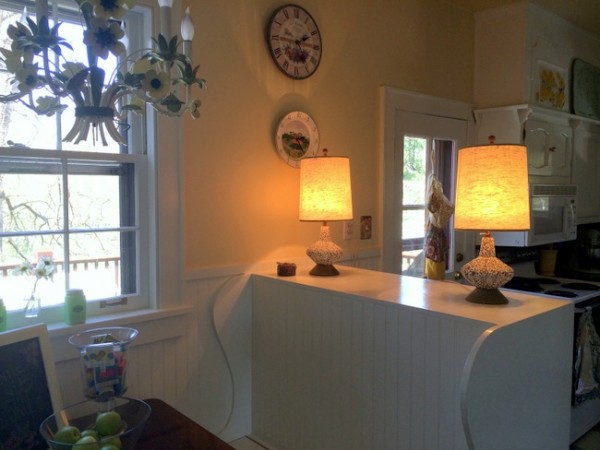Table of Contents
When it comes to designing your bedroom, lighting plays a crucial role in setting the mood, enhancing functionality and creating a comfortable and inviting space. Effective lighting design combines aesthetics with practicality, transforming your bedroom into a versatile haven that meets your needs from morning to night. In this article, we’ll explore the art of lighting design in the bedroom and how to strike the perfect balance between ambiance and functionality.
When it comes to designing your bedroom, lighting serves as the unsung hero that can truly make or break the ambiance and functionality of your personal sanctuary. Much like a painter uses various brush strokes and colors to create a masterpiece, you can use different lighting elements and techniques to craft the perfect mood and atmosphere in your bedroom.
The art of lighting design in the bedroom goes far beyond simply choosing a few fixtures and placing them around the room. It’s about understanding how light can shape our perception of space and emotions. Here, we’ll delve deeper into the intricacies of bedroom lighting and guide you on how to masterfully blend aesthetics with practicality.
1. Layers of Light: Consider your bedroom as a canvas and lighting as the brushstrokes. To achieve a harmonious balance, think in terms of layers. Start with the foundational layer – ambient lighting. This can be achieved through overhead fixtures, such as chandeliers or recessed lighting. Ambient light sets the overall tone for your room, providing a gentle, even illumination that ensures you can navigate the space comfortably.
2. Task-Oriented Illumination: Next, incorporate task lighting to enhance functionality. These are focused lights that cater to specific activities, such as reading or dressing. Bedside table lamps, wall-mounted reading lights or a vanity mirror with LED bulbs are excellent choices. Task lighting not only aids in functionality but also adds character to your room.
3. Accentuate Your Style: To truly personalize your space, use accent lighting to highlight architectural features, artwork or any design elements you wish to showcase. LED strip lights hidden behind a headboard, under a bed frame or along shelves can add a touch of drama and elegance, transforming your bedroom into a visual delight.
4. Dimmers for Mood Control: Don’t underestimate the power of dimmers. Installing dimmer switches allows you to adjust the intensity of your lighting, adapting it to your current mood or activity. Lower the lights for a cozy, intimate atmosphere or brighten them up when you need to focus and get things done.
5. Color Temperature Matters: Consider the color temperature of your light sources. Warm white light (around 2700K) tends to create a cozy and inviting ambiance, while cool white light (around 4000K) is better for a crisp and energetic atmosphere. Play with these temperatures to find the right balance for your personal haven.
6. Smart Lighting Solutions: Embrace technology by incorporating smart lighting solutions. With voice commands or smartphone apps, you can effortlessly control the brightness and color of your lights. This not only adds convenience but also opens up endless possibilities for customization.
7. Personalization and Flexibility: Remember that your bedroom is your haven and your lighting design should reflect your unique tastes and needs. It’s essential to create a versatile space that can adapt to your changing requirements from morning to night. Experiment, tweak and evolve your lighting design as your preferences evolve over time.
In conclusion, lighting in the bedroom is not just about aesthetics; it’s about crafting an atmosphere that resonates with your personality and supports your daily activities. By carefully layering different types of lighting, incorporating smart technology and paying attention to the finer details like color temperature, you can achieve a bedroom that is both functional and emotionally satisfying. So, let your creativity shine and illuminate your bedroom in a way that truly makes it your own tranquil haven.
Looking for more insights? You’ll find them right here in our extended coverage: The Importance of Architectural Lighting | TCP Lighting Solutions
Layered Lighting
The key to a well-lit bedroom is layering. Instead of relying on a single, harsh overhead light, use a combination of different light sources to create depth and flexibility. The three primary layers of lighting to consider are:
Creating a well-lit bedroom through the art of layering is not only about illuminating the space but also about crafting a comfortable and inviting atmosphere. By strategically blending different light sources, you can enhance the functionality and aesthetics of your bedroom. Here’s an extended perspective on the three primary layers of bedroom lighting:
Ambient Lighting – The Foundation of Illumination:
- Ambient lighting forms the base layer of bedroom illumination. It sets the overall tone and brightness of the room, ensuring that you have a well-lit space to move around in. Consider these aspects:
- Overhead Fixtures: Ceiling-mounted fixtures, such as chandeliers, pendant lights or ceiling fans with built-in lighting, provide even, general illumination. Opt for fixtures that complement your bedroom’s style and decor.
- Recessed Lighting: Recessed ceiling lights are a sleek and modern option for ambient lighting. They distribute light evenly and can be dimmable for versatility.
- Wall Sconces: Wall-mounted sconces can also contribute to ambient lighting. They add a touch of elegance and can be positioned to create soft, indirect illumination.
- Ambient lighting forms the base layer of bedroom illumination. It sets the overall tone and brightness of the room, ensuring that you have a well-lit space to move around in. Consider these aspects:
Task Lighting – Precision and Functionality:
- Task lighting serves specific purposes in the bedroom, illuminating areas where you engage in activities that require focused light. This layer enhances functionality and can be tailored to your needs:
- Bedside Lamps: Table lamps or wall-mounted swing-arm lamps on either side of the bed provide targeted lighting for reading, working or winding down before sleep.
- Vanity Lighting: If your bedroom includes a vanity or dressing area, consider well-placed vanity lighting with adjustable fixtures to provide even and flattering light for grooming and getting ready.
- Desk Lighting: If your bedroom doubles as a workspace, a desk lamp with adjustable brightness can minimize eye strain and improve productivity.
- Task lighting serves specific purposes in the bedroom, illuminating areas where you engage in activities that require focused light. This layer enhances functionality and can be tailored to your needs:
Accent Lighting – Adding Drama and Depth:
- Accent lighting is the final layer that adds drama, depth and a touch of personality to your bedroom. It highlights specific elements, decor or architectural features:
- Artwork Lighting: Picture lights or wall-mounted fixtures can showcase artwork, photographs or decorative items, drawing attention to these focal points.
- Under-Cabinet Lighting: If you have built-in shelves, cabinets or niches, consider under-cabinet or shelf lighting to create a visually striking display.
- Floor Uplighting: Placing small uplights on the floor near large potted plants or decorative screens can create captivating silhouettes and a sense of depth.
- Accent lighting is the final layer that adds drama, depth and a touch of personality to your bedroom. It highlights specific elements, decor or architectural features:
Additional Tips for Effective Bedroom Lighting:
- Dimmer Switches: Install dimmer switches for your ambient and task lighting. This allows you to adjust the brightness according to different activities and moods, from bright and invigorating to soft and cozy.
- Color Temperature: Pay attention to the color temperature of your light bulbs. Warmer tones (e.g., 2700K) are calming and suitable for bedrooms, while cooler tones (e.g., 4000K) can be energizing.
- Layering with Textiles: Don’t forget to incorporate lighting elements in your textiles, such as bedside lampshades, pendant light shades or even illuminated headboards for a stylish twist.
- Safety and Accessibility: Ensure that switches and controls are easily accessible from the bed, allowing for convenience and safety during nighttime movements.
In conclusion, the art of lighting in your bedroom lies in creating a harmonious blend of ambient, task and accent lighting. Each layer serves a specific purpose, contributing to the functionality, aesthetics and ambiance of the space. By carefully considering the design and placement of these light sources, you can transform your bedroom into a well-lit haven that caters to your every need, from relaxation to productivity.
Looking for more insights? You’ll find them right here in our extended coverage: The Art of Layered Lighting: How to Create Depth and Ambiance in …

Ambient Lighting
This is your general, overall lighting that provides a comfortable level of brightness throughout the room. Ceiling fixtures, chandeliers or recessed lighting can serve as ambient lighting sources.
Ambient lighting, often referred to as general lighting, is the cornerstone of any well-lit room. It sets the stage, providing a uniform and comfortable level of illumination that ensures your space is inviting and functional. Here’s an extended look at the importance of ambient lighting and how different fixtures can fulfill this essential role:
Warmth and Comfort: Ambient lighting envelops your room in a warm and inviting glow. It eliminates harsh shadows and creates a sense of comfort and coziness, making your space feel more welcoming. This soft and diffused light is particularly essential in bedrooms, living rooms and dining areas where you want to foster a relaxed atmosphere.
Versatile Applications: Ambient lighting is highly versatile and can be adapted to suit various room sizes and functions. In larger spaces, ceiling fixtures like chandeliers or pendant lights provide broad coverage, while in smaller rooms, recessed lighting or flush mount fixtures are excellent choices. The flexibility of ambient lighting allows you to customize the level of brightness to match your preferences and needs.
Balanced Illumination: One of the key advantages of ambient lighting is that it ensures a balanced distribution of light throughout the room. It helps eliminate dark corners and ensures that every area is adequately illuminated. This balanced approach enhances safety, as it reduces the risk of accidents or stumbling in poorly lit areas.
Room’s Aesthetic: The choice of fixtures for ambient lighting can significantly impact the overall aesthetics of your room. A stylish chandelier can serve as a focal point in your dining room, adding elegance and sophistication. In contrast, recessed lighting offers a minimalist and unobtrusive appearance, allowing other design elements to take center stage.
Dimming Capabilities: To further enhance the versatility of ambient lighting, consider incorporating dimming capabilities. Dimmable ambient lighting fixtures allow you to adjust the brightness to suit different activities and moods. Lowering the intensity for movie nights or increasing it for reading or entertaining can transform your room’s ambiance effortlessly.
Energy Efficiency: With advancements in lighting technology, you can choose energy-efficient options for your ambient lighting. LED fixtures, for example, consume significantly less energy than traditional incandescent bulbs. This not only reduces your environmental footprint but also lowers your energy bills over time.
Layered Lighting: While ambient lighting forms the foundation, it’s often more effective when combined with other layers of lighting, such as task and accent lighting. This layered approach allows you to tailor the lighting in your room for specific purposes. For instance, in a kitchen, ambient lighting can be complemented by under-cabinet task lighting for food preparation and pendant lights for dining.
Enhanced Room Functionality: Ultimately, ambient lighting contributes to the overall functionality of your space. It ensures that you can comfortably navigate and engage in various activities, from reading and cooking to socializing and relaxing. The right level of illumination can make your room more versatile and adaptable to your lifestyle.
In summary, ambient lighting serves as the backbone of your room’s lighting design. It creates a warm and inviting atmosphere, balances illumination, enhances the room’s aesthetics, offers dimming capabilities, promotes energy efficiency and enhances room functionality. By choosing the appropriate ambient lighting fixtures and considering a layered lighting approach, you can create a well-lit and versatile space that suits your needs and complements your design preferences.
Should you desire more in-depth information, it’s available for your perusal on this page: The Importance Of Lighting In Interior Design
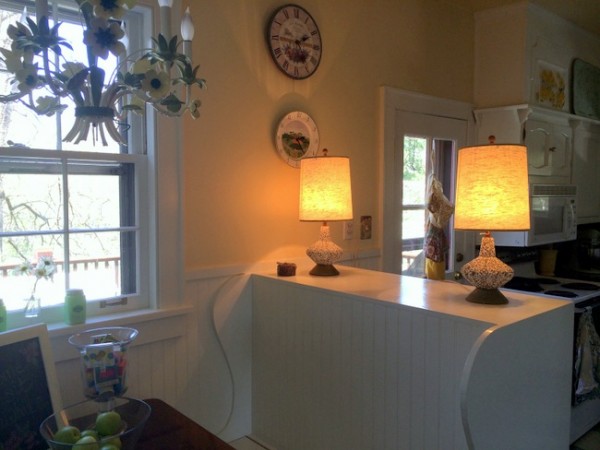
Task Lighting
Task lighting is focused illumination that helps you perform specific activities. Examples include reading lamps, bedside table lamps or wall-mounted sconces. Task lighting should be adjustable and positioned for optimal functionality.
Task lighting is the unsung hero of functionality and productivity in any space. Its role extends far beyond simply brightening a room; it’s about tailoring the lighting to your specific needs and activities. Here’s an in-depth exploration of why task lighting is indispensable and how it can transform the way you work, read or engage in various activities:
Enhanced Focus and Concentration: Task lighting provides concentrated illumination precisely where you need it most. Whether you’re working at a desk, reading a book or crafting, the focused light minimizes distractions and enhances your ability to concentrate on the task at hand.
Minimized Eye Strain: Insufficient or improperly positioned lighting can strain your eyes, leading to discomfort and reduced productivity. Task lighting ensures that your work area is well-lit, reducing the risk of eye strain and fatigue.
Customizable Illumination: The adjustability of task lighting is a key feature. You can tailor the angle and intensity of the light to suit your preferences and the specific requirements of your activity. This customization promotes comfort and efficiency.
Optimal Reading Conditions: Reading lamps, in particular, are designed to create the perfect ambiance for reading. They provide a warm and inviting glow that is easy on the eyes, making reading a more enjoyable and immersive experience.
Bedside Convenience: Bedside table lamps or wall-mounted sconces are invaluable additions to your bedroom. They allow for easy access to light for nighttime reading or other activities without disturbing your partner’s sleep.
Task-Specific Solutions: Task lighting comes in a variety of forms tailored to specific needs. For instance, magnifying lamps are ideal for detailed tasks like crafting or sewing, while under-cabinet lighting in the kitchen ensures you have ample light for food preparation.
Artistic Accent: Task lighting can also serve as a form of artistic accent. Wall-mounted sconces, for example, can double as decorative elements that enhance the aesthetics of your space while providing functional lighting.
Energy Efficiency: Task lighting is energy-efficient. By focusing light where it’s needed, it reduces the need for overall ambient lighting, helping you save on energy costs and reduce your environmental footprint.
Versatility: Task lighting isn’t limited to just one room or one type of activity. It can be versatile, with adjustable fixtures that can be repurposed to meet different lighting needs throughout your home.
Circadian Rhythm Support: Some task lighting fixtures offer tunable white light, allowing you to adjust the color temperature. This feature can help support your circadian rhythm by providing cooler, more energizing light during the day and warmer, relaxing light in the evening.
Dimming Options: Many task lighting options offer dimming capabilities. This flexibility allows you to set the mood for different activities, from bright and focused for work to soft and cozy for relaxation.
Safety and Security: Task lighting can enhance safety and security. Well-lit stairways, hallways and entryways reduce the risk of accidents and deter potential intruders, providing peace of mind.
In summary, task lighting is a versatile and indispensable aspect of any well-designed space. It’s not just about illumination; it’s about creating an environment that promotes productivity, comfort and well-being. By strategically incorporating adjustable and task-specific lighting solutions into your home or workspace, you can elevate your experience and transform ordinary tasks into enjoyable and efficient activities.
Additionally, you can find further information on this topic by visiting this page: The Importance of Lighting in Interior Design: Creating a Functional …

Accent Lighting
Accent lighting adds drama and visual interest to your bedroom. It’s used to highlight artwork, architectural features or specific areas of the room. This can be achieved with track lighting, spotlights or even LED strips.
Accent lighting adds drama and visual interest to your bedroom. It’s used to highlight artwork, architectural features or specific areas of the room. This can be achieved with track lighting, spotlights or even LED strips. Here are some compelling reasons to incorporate accent lighting into your bedroom design:
Highlighting Artistry: If you have a cherished art piece or a collection of artworks, accent lighting can bring them to life. The focused illumination draws attention to the details and colors of the artwork, making it a captivating focal point in your bedroom.
Architectural Emphasis: If your bedroom has unique architectural features such as exposed beams, a decorative ceiling or a built-in alcove, accent lighting can accentuate these elements. It adds depth and dimension to the space, making it feel more dynamic and visually appealing.
Creating Ambiance: Accent lighting is perfect for setting the mood in your bedroom. Dimmable options allow you to adjust the intensity of the light to match your desired atmosphere, whether it’s a romantic, cozy glow or a brighter, more invigorating feel.
Task Lighting: While accent lighting primarily serves an aesthetic purpose, it can also double as task lighting. For example, adjustable wall-mounted spotlights can provide focused illumination for reading in bed or working at a desk, adding functionality to the room.
Spatial Definition: In larger bedrooms, accent lighting can help define different areas or zones. For instance, you can use it to delineate a reading nook, a dressing area or a cozy seating arrangement, creating a sense of purpose and organization within the room.
Versatile Options: The variety of accent lighting options available allows you to customize the look and feel of your bedroom. From sleek and modern track lighting to the soft and ambient glow of LED strips, you can choose fixtures that align with your style and preferences.
Energy Efficiency: Many accent lighting solutions are energy-efficient, especially LED options. They not only reduce your electricity bills but also have a longer lifespan, minimizing the need for frequent bulb replacements.
Easy Installation: Installing accent lighting doesn’t have to be a complex project. Many options are designed for simple installation, making it accessible for homeowners looking to enhance their bedroom’s aesthetics without extensive renovation.
In conclusion, accent lighting is a versatile and impactful addition to your bedroom’s design. It goes beyond functional illumination, adding layers of visual interest and ambiance. Whether you aim to showcase artworks, create a cozy reading nook or emphasize architectural details, accent lighting allows you to personalize your space and enhance its overall appeal. It’s a subtle yet powerful tool for transforming your bedroom into a welcoming and visually captivating retreat.
Additionally, you can find further information on this topic by visiting this page: Layering Lighting – How To Layer Your Home’s Lighting | Lumens

Dimmer Switches
Installing dimmer switches for your bedroom lights provides the ultimate control over ambiance. Dimming allows you to adjust the brightness according to your mood and needs. Lower levels of light in the evening create a relaxing atmosphere, while brighter settings in the morning promote alertness and productivity.
“Dimmer switches are an invaluable addition to your bedroom’s lighting design, offering a wide range of benefits beyond mere brightness control. Here’s why they provide the ultimate control over ambiance and how you can make the most of them:
1. Customizable Atmosphere: Dimmer switches give you the ability to customize the atmosphere in your bedroom to suit different occasions and moods. Whether you’re winding down for a peaceful evening, hosting a cozy gathering or need a well-lit space for work or reading, dimming the lights to your preferred level sets the stage perfectly.
2. Stress Reduction: Lowering the lights in the evening creates a calming and stress-reducing environment. The gentle, warm glow can help signal to your body that it’s time to relax and unwind, making it easier to transition into a peaceful state of mind for a restful night’s sleep.
3. Energy Efficiency: Dimming your bedroom lights not only enhances ambiance but also conserves energy. When lights are dimmed, they consume less electricity, reducing your energy bills and environmental footprint. It’s an eco-friendly way to enjoy a well-lit space without excessive energy consumption.
4. Eye Comfort: Bright lighting in the morning can be harsh on the eyes, especially right after waking up. By starting with dimmed lighting and gradually increasing it, you allow your eyes to adjust comfortably, promoting a smoother and more pleasant morning routine.
5. Visual Impact: Dimmer switches can highlight and accentuate various aspects of your bedroom decor. Whether it’s an art piece, architectural feature or a unique design element, adjusting the lighting levels allows you to create visual impact and draw attention to specific areas or objects.
6. Flexibility for Tasks: When you need to perform tasks like reading or getting dressed, brighter lighting is essential. Dimmer switches offer the flexibility to easily increase the light levels for these activities, ensuring you have the right amount of illumination precisely where you need it.
7. Better Sleep Hygiene: Maintaining a consistent sleep schedule is crucial for good sleep hygiene. Dimming the lights as bedtime approaches serves as a visual cue that it’s time to wind down. This simple routine can help regulate your sleep patterns and improve the quality of your rest.
8. Increased Longevity: Dimming your lights can also extend the life of your bulbs. Lower light levels reduce the wear and tear on the filaments, leading to longer-lasting bulbs and fewer replacements.
Incorporating dimmer switches into your bedroom lighting design empowers you to create a versatile, comfortable and energy-efficient space. It allows you to adapt your lighting to your daily activities and moods seamlessly. With the ultimate control over ambiance that dimmers provide, your bedroom becomes a haven where you can unwind, work, socialize and sleep, all with just a flick of a switch.”
To delve further into this matter, we encourage you to check out the additional resources provided here: BEDROOM LIGHTING IDEAS TO ENHANCE COMFORT – Brecher’s …
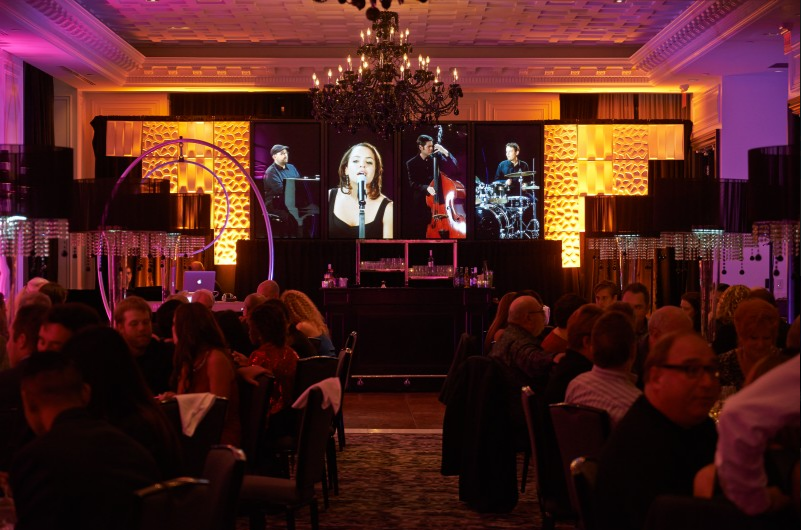
Bedside Lighting
Bedside lighting is particularly important for reading, relaxation and convenience. Consider adjustable wall-mounted sconces, pendant lights or table lamps that are easily accessible from your bed. Opt for fixtures with adjustable arms or shades to direct light precisely where you need it.
Creating the perfect bedside lighting setup goes beyond functionality; it’s about curating a comfortable and inviting atmosphere tailored to your needs. Expanding on the importance of bedside lighting and the versatility of fixtures, here are some additional insights to consider:
Multiple Light Sources: Instead of relying on a single source of bedside light, consider incorporating multiple light fixtures. This approach allows you to layer lighting, creating different levels of illumination for various activities. For instance, pair a pendant light for ambient lighting with an adjustable table lamp for focused reading.
Task Lighting: Bedside lighting serves various purposes, including reading, working and relaxation. Task lighting is essential for specific activities, so choose fixtures that provide ample illumination without causing glare or eye strain. Adjustable wall-mounted sconces with swivel arms are perfect for directing light exactly where you need it.
Dimmer Switches: Install dimmer switches for your bedside lights. Dimmers give you complete control over the light intensity, allowing you to create a soothing, low-light ambiance for winding down at night or bright, task-focused lighting for reading or working in bed.
Color Temperature: Consider the color temperature of your bedside light bulbs. Cooler temperatures (around 4000K) can be energizing for reading or tasks, while warmer temperatures (around 2700K) create a cozy and relaxing atmosphere. Some modern fixtures even offer adjustable color temperature settings to suit your preferences.
Integrated Charging: In our tech-centric lives, bedside lighting fixtures with built-in USB ports or wireless charging capabilities can be incredibly convenient. You can keep your devices charged and within reach, reducing clutter on your nightstand.
Swing-Arm Lamps: Swing-arm lamps are versatile bedside lighting options that allow you to adjust the angle and position of the light source. This flexibility is perfect for bedtime readers who want to angle the light just right without disturbing their partner.
Style and Aesthetics: Your choice of bedside lighting should harmonize with your bedroom’s decor and your personal style. Explore a variety of fixture styles, from minimalist and modern to vintage and ornate, to find the perfect fit for your space.
Accessibility: Ensure that turning on and off your bedside lights is hassle-free. Whether through a pull chain, touch-sensitive base or remote control, easy accessibility to the lighting controls is essential for your convenience.
Hidden Lighting: Consider installing concealed lighting under your bed or behind a headboard for a soft and ambient glow. This indirect lighting can create a tranquil and visually appealing atmosphere in your bedroom.
Safety and Design: Be mindful of the design and placement of your bedside lighting to prevent tripping hazards. Ensure that cords are secured and not in your walking path. Wall-mounted fixtures can help eliminate cords altogether.
Personal Touch: Personalize your bedside lighting with shades or fixtures that reflect your personality. Custom lampshades, DIY lighting projects or vintage finds can add character and uniqueness to your bedroom.
Maintenance: Regularly clean and dust your bedside lighting fixtures to maintain their appearance and functionality. Replacing burnt-out bulbs promptly ensures you always have well-lit and inviting bedside lighting.
Bedside lighting is a versatile tool that can transform your bedroom into a soothing retreat or a functional workspace, depending on your needs. By considering the various aspects of lighting, including adjustability, style and convenience, you can create a customized lighting setup that enhances both the aesthetics and functionality of your sleep sanctuary.
Explore this link for a more extensive examination of the topic: Bedroom Lighting – Bee Ridge Lighting
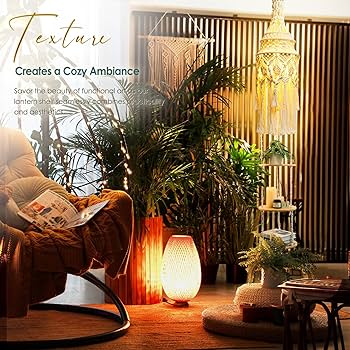
Color Temperature
Pay attention to the color temperature of your light sources. Warmer, soft white or warm white lights (around 2700-3000 Kelvin) are cozy and relaxing, ideal for evening use. Cooler, daylight or cool white lights (around 5000-6500 Kelvin) are energizing and suitable for tasks like reading and dressing in the morning.
Pay attention to the color temperature of your light sources, as it plays a significant role in setting the mood and functionality of your space. Choosing the right color temperature can transform your bedroom into a haven of comfort and productivity.
For evening use and winding down before bed, opt for warmer, soft white or warm white lights in the range of 2700-3000 Kelvin. These gentle, yellowish hues create a cozy and relaxing atmosphere, perfect for unwinding with a good book or engaging in a calming nighttime routine. Warm lighting can also promote better sleep by minimizing the disruption of your circadian rhythm, helping you ease into a restful slumber.
Conversely, for tasks that require focus and energy in the morning or daytime, cooler, daylight or cool white lights in the range of 5000-6500 Kelvin are ideal. These crisp, bluish-white tones simulate natural daylight and provide an invigorating ambiance. They’re excellent for activities like reading, working or getting dressed, as they enhance visibility and help you stay alert and attentive.
Consider incorporating dimmable lighting fixtures or smart bulbs into your bedroom to have precise control over the color temperature throughout the day. This allows you to adjust the lighting to your needs, transitioning smoothly from a gentle, warm glow in the evening to a vibrant, cool light in the morning.
Remember that the right lighting can significantly impact your mood and productivity, so take the time to curate a lighting scheme that complements your daily routines and personal preferences. By paying attention to color temperature, you can create a bedroom that seamlessly adapts to your lifestyle, enhancing both your comfort and functionality.
Looking for more insights? You’ll find them right here in our extended coverage: 7 Essential Retail Lighting Design Guidelines for 2023

Smart Lighting
Consider integrating smart lighting solutions into your bedroom. Smart bulbs and systems allow you to control your lighting remotely through smartphone apps or voice commands. You can schedule lighting changes, set scenes for different activities and even change colors to suit your preferences.
Elevating your bedroom’s ambiance and functionality takes just a few taps on your smartphone or a voice command when you embrace smart lighting solutions. Let’s delve deeper into the myriad benefits and creative possibilities these innovations bring to your sleep sanctuary:
Mood Enhancement: Smart lighting is the maestro of mood-setting. Whether you want a serene and dimly lit atmosphere for winding down before sleep or vibrant, energizing lighting for morning routines, you can easily adjust the brightness and color temperature to match your desired mood.
Personalized Scenes: Create personalized scenes for different activities. A “Reading” scene might have warm, focused lighting, while a “Movie Night” scene could feature soft, immersive colors. These scenes can be activated with a single command, making transitions effortless.
Color Customization: Smart bulbs offer an entire spectrum of colors. Explore and personalize your space with a palette that suits your style. You can even choose colors that correspond to your favorite books, movies or music for a truly immersive experience.
Wake-Up and Sleep Aids: Gradually brighten your lights in the morning to simulate a natural sunrise, gently waking you up and helping you start your day feeling refreshed. At night, use warm, dimmed lighting to signal your body that it’s time to wind down for restful sleep.
Energy Efficiency: Smart bulbs are energy-efficient, allowing you to reduce energy consumption and lower your electricity bills. You can set timers and schedules to ensure lights are only on when needed.
Voice Control: Voice assistants like Amazon Alexa or Google Assistant seamlessly integrate with smart lighting systems. You can simply say, “Hey, Google, dim the bedroom lights,” to create the desired ambiance without lifting a finger.
Remote Control: Forgot to turn off the lights before leaving home? No problem. With remote access through smartphone apps, you can control your bedroom lights from anywhere, ensuring energy savings and peace of mind.
Security: Smart lighting can enhance home security. You can set up lighting schedules to simulate your presence at home, deterring potential intruders when you’re away.
Customized Routines: Create lighting routines that align with your daily activities. For instance, a “Good Morning” routine can gradually brighten the lights, while a “Bedtime” routine can gently fade them out, promoting a tranquil bedtime ritual.
Integration with Other Devices: Smart lighting can integrate with other smart home devices. You can set it to work in harmony with your smart thermostat, music system or even your morning coffee maker for a seamless morning routine.
Guest Mode: Hosting guests? Share guest access to your smart lighting system, allowing them to adjust their bedroom lighting to their liking without the need for complicated instructions.
Easy Installation: Most smart bulbs and lighting systems are designed for easy installation, making it accessible to those without advanced technical skills.
In conclusion, integrating smart lighting solutions into your bedroom is like having a personal lighting designer at your beck and call. It not only elevates the aesthetics and functionality of your sleep sanctuary but also offers convenience, energy savings and endless possibilities for personalization. Embrace the power of smart lighting and you’ll wonder how you ever lived without it in your modern retreat.
Additionally, you can find further information on this topic by visiting this page: Smart lighting | Philips Hue US
Concealed Lighting
For a touch of elegance, consider concealed lighting. LED strips can be discreetly installed under furniture, along the headboard or within shelving units to create a soft, indirect glow. This adds a sense of depth and sophistication to your bedroom.
Creating an elegant bedroom ambiance involves careful attention to lighting and concealed lighting is a sophisticated choice that can elevate the overall aesthetic. Here are some additional insights and ideas for using concealed lighting effectively:
Customizable Ambiance: Concealed LED strips offer the advantage of customizable lighting. You can adjust the intensity and color temperature to suit different moods and activities. For example, opt for warm, dimmed lighting for a cozy evening atmosphere and choose brighter, cooler tones for reading or getting ready in the morning.
Highlighting Architectural Features: Concealed lighting is ideal for highlighting architectural features in your bedroom. Illuminate crown molding, tray ceilings or alcoves to draw attention to these design elements and create a visually stunning focal point.
Under-Bed Lighting: Install LED strips under your bed frame to create the illusion of a floating bed. This not only adds a touch of magic but also provides functional lighting for late-night navigation without disturbing your partner.
Backlit Headboard: Concealed lighting behind the headboard can create a stunning, ethereal effect. It not only makes a statement but also serves as a soft, gentle reading light for bedtime stories or nighttime reading.
Wardrobe and Closet Lighting: For added convenience, consider installing concealed lighting inside your wardrobe or closet. This ensures that you can easily see and access your clothing and accessories, streamlining your morning routine.
Floating Shelves and Display Units: Incorporate concealed lighting into floating shelves or display units to showcase your decor, art pieces or collectibles. The gentle glow accentuates these items and adds a touch of drama to your bedroom decor.
Creating Zones: Use concealed lighting to define different zones within your bedroom. For instance, you can have ambient lighting for relaxation and brighter lighting near a vanity or workspace area for practicality.
Hidden Wiring: To maintain a clean and seamless look, hide wiring effectively. Recessed channels or tracks can keep wires hidden and prevent them from being a distraction.
Smart Lighting Control: Pair concealed lighting with smart lighting control systems. You can schedule lighting changes, adjust brightness with voice commands or control the lighting remotely through your smartphone, offering both convenience and energy savings.
Energy Efficiency: LED strips are energy-efficient and have a longer lifespan compared to traditional bulbs. This means that not only will you enjoy the aesthetic benefits of concealed lighting, but you’ll also reduce your energy consumption and save on utility bills.
Safety and Security: Concealed lighting can enhance safety and security. Soft, low-level lighting along pathways or near exits can guide you safely in the dark and act as a deterrent to potential intruders.
Personalize with Colors: To add a personal touch, consider LED strips that allow you to choose from a spectrum of colors. You can match the lighting to your bedroom’s color scheme or even set dynamic color-changing scenes for special occasions.
Incorporating concealed lighting into your bedroom design goes beyond aesthetics; it enhances functionality, comfort and the overall experience of your space. Whether you’re aiming for a romantic, tranquil retreat or a versatile modern bedroom, concealed lighting can be a key element in achieving the desired atmosphere and ambiance.
Should you desire more in-depth information, it’s available for your perusal on this page: Living Room Lighting Ideas: 39 Ways To Decorate And Illuminate …
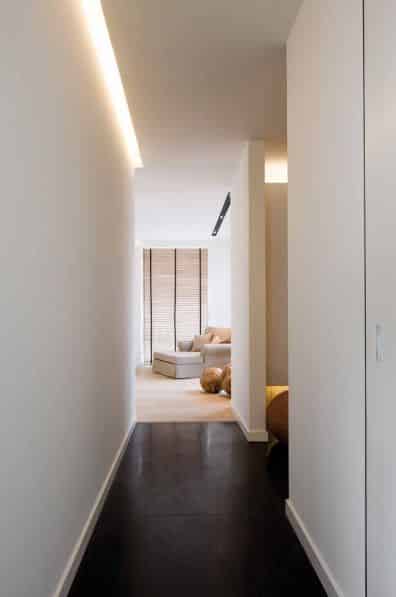
Safety and Accessibility
Don’t forget about safety and accessibility when designing your bedroom lighting. Ensure that pathways are well-lit to prevent accidents during nighttime trips to the bathroom. Consider motion-activated lights for these areas to provide automatic illumination when needed.
Safety and accessibility should be paramount considerations when crafting the lighting design for your bedroom. Beyond creating a cozy ambiance, lighting can also be a crucial element in preventing accidents and ensuring ease of movement, especially during the dark hours of the night. Here are some additional tips to enhance the safety and accessibility of your bedroom lighting:
1. Layered Lighting: Opt for a layered lighting approach that combines ambient, task and accent lighting. Ambient lighting provides overall illumination, while task lighting focuses on specific activities like reading or working. Accent lighting adds depth and highlights certain features. This combination allows you to adjust the lighting according to your needs and activities, promoting both safety and comfort.
2. Nightlights: Nightlights are a simple yet effective solution to guide your way during nighttime visits to the bathroom or other areas of your bedroom. Place them strategically in hallways, near steps or in the bathroom itself. Choose low-intensity, warm-toned LED nightlights to avoid disrupting your sleep.
3. Motion-Activated Lights: Motion-activated lights are a game-changer for bedroom safety and convenience. Install them in key areas like the hallway leading to the bathroom or in closets. These lights automatically turn on when they detect motion, providing illumination without the need to fumble for light switches in the dark.
4. Adjustable Bedside Lamps: Bedside lamps with adjustable arms or dimmer switches give you control over the intensity and direction of the light. This feature is especially useful for reading or performing tasks in bed, ensuring that you have ample light without straining your eyes.
5. Non-Glare Lighting: Choose fixtures and bulbs that emit soft, diffused light to reduce glare and minimize the risk of discomfort or eye strain. Shades, frosted bulbs or recessed fixtures with baffles can help achieve this effect.
6. Light Switch Placement: Position light switches at convenient locations, ensuring that they are easily accessible from your bed and other key areas. Consider installing illuminated switches for added visibility in the dark.
7. Emergency Lighting: In case of power outages, having emergency lighting options can be a lifesaver. Battery-powered lanterns or flashlights strategically placed in your bedroom can provide essential light during such situations.
8. Smart Lighting Solutions: Invest in smart lighting systems that allow you to control your bedroom lights remotely through your smartphone or voice-activated assistants. This technology can be particularly helpful for adjusting lighting from the comfort of your bed, enhancing both safety and convenience.
9. Regular Maintenance: Keep your lighting fixtures and bulbs in good working condition by performing regular maintenance checks. Replace burnt-out bulbs promptly and ensure that all fixtures are secure to prevent accidents.
By incorporating these safety and accessibility considerations into your bedroom lighting design, you not only create a more secure and functional sleep sanctuary but also enhance your overall quality of life. A well-lit bedroom not only promotes safety but also contributes to a more relaxed and comfortable atmosphere for your nighttime routines and daily activities.
Explore this link for a more extensive examination of the topic: Senses of place: architectural design for the multisensory mind …

Personalization
Ultimately, your bedroom lighting design should reflect your personal style and preferences. Choose fixtures and designs that resonate with you and complement your bedroom decor. Lighting is not only functional but also an integral part of your bedroom’s aesthetic.
Your bedroom lighting design holds the power to transform your space into a personalized haven that aligns with your unique taste and preferences. Beyond its functional aspect, lighting serves as a fundamental component of your bedroom’s overall aesthetic. Here’s how you can further enhance your bedroom’s ambiance by curating the perfect lighting design:
Layered Lighting: To achieve a versatile and harmonious lighting scheme, consider incorporating multiple layers of light. This includes ambient lighting (main light source), task lighting (focused illumination for activities like reading) and accent lighting (for highlighting specific features or decor). Layered lighting allows you to adjust the mood and functionality of your room according to different needs and occasions.
Dimmer Controls: Installing dimmer switches for your bedroom lights offers the flexibility to adjust the brightness according to your mood and the time of day. Lowering the lights in the evening can create a cozy and relaxing atmosphere, while brighter lighting during the day can make the room feel more vibrant and energized.
Fixture Selection: Pay attention to the style of lighting fixtures you choose. From sleek and modern fixtures to vintage or rustic designs, the choice of fixtures can significantly influence the overall look and feel of your bedroom. Ensure they complement your decor theme and personal style.
Color Temperature: The color temperature of your bedroom lighting can impact the room’s ambiance. Warm white or soft yellow tones create a cozy and inviting atmosphere, while cool white or daylight tones are more suitable for tasks that require focused illumination.
Natural Light: If possible, maximize natural light in your bedroom by using light and airy window treatments. Natural light not only enhances the room’s aesthetic but also contributes to your well-being by regulating your sleep-wake cycle and boosting your mood.
Statement Pieces: Consider incorporating lighting fixtures that double as decorative statement pieces. Chandeliers, pendant lights or artistic wall sconces can serve as focal points in your bedroom, adding a touch of elegance and personality.
Customization: Personalize your lighting design further with smart lighting solutions. These allow you to control the color, intensity and even the scheduling of your lights using your smartphone or voice commands. Customizing your lighting based on your daily routines can enhance both comfort and energy efficiency.
Safety and Accessibility: Ensure that your lighting design prioritizes safety and accessibility. Install well-placed nightlights or motion-activated lights to navigate the bedroom safely at night. Adequate lighting in closets and dressing areas can make daily routines more efficient.
Remember, your bedroom lighting is not just about functionality; it’s a means of self-expression and a way to set the desired mood in your private sanctuary. Take the time to carefully curate your lighting design and you’ll find that it not only illuminates your space but also adds depth, character and a welcoming ambiance that truly reflects your personal style and preferences.
Looking for more insights? You’ll find them right here in our extended coverage: Signify launches new Philips Hue products and features | Signify …

In conclusion, effective lighting design is a fundamental aspect of creating ambiance and functionality in your bedroom. By incorporating layered lighting, dimmer switches and thoughtful fixture choices, you can transform your bedroom into a versatile and inviting space that adapts to your needs throughout the day. Personalization, safety and smart solutions further enhance the overall experience, ensuring that your bedroom is both a comfortable retreat and a functional living space.
To sum up, the significance of effective lighting design cannot be overstated when it comes to shaping the atmosphere and usability of your bedroom. It is the cornerstone upon which your entire bedroom experience is built. Through the strategic implementation of layered lighting, the installation of dimmer switches and the careful selection of fixtures, you have the power to metamorphose your bedroom into a multifaceted haven that accommodates your desires from morning to night.
Layered Lighting: The concept of layered lighting is akin to an artist working with different shades and strokes on a canvas. It allows you to orchestrate the mood within your bedroom with precision. Soft ambient lighting can create a soothing backdrop, while task lighting at your bedside ensures that reading or working is a breeze. Accent lighting, strategically placed to highlight artwork or architectural features, adds depth and character to the space. By layering these lighting types, you wield control over the bedroom’s ambiance, crafting it to perfection.
Dimmer Switches: The introduction of dimmer switches is akin to having a volume control for your lighting. This simple addition grants you the ability to tailor the brightness according to your activities and preferences. Whether you desire a gentle, low-lit setting for winding down in the evening or bright, invigorating illumination for morning routines, dimmer switches offer the flexibility to adapt your lighting to your mood and requirements.
Thoughtful Fixture Choices: The fixtures you choose act as both functional tools and decorative elements. Opt for fixtures that complement your bedroom’s style and personality. From elegant chandeliers to minimalist pendant lights or sleek wall sconces, these fixtures can serve as focal points and contribute to the overall aesthetics of the room. Thoughtful fixture selection harmonizes form and function, enhancing the visual appeal of your sanctuary.
Personalization, Safety and Smart Solutions: Don’t forget that personalization is the key to making your bedroom uniquely yours. Incorporate elements that resonate with your individual style and preferences. Additionally, consider safety aspects in your lighting design, ensuring that wires and outlets are properly concealed to minimize hazards.
Lastly, the integration of smart solutions can catapult your bedroom into the future. With smart lighting systems, you can control your bedroom’s lighting with the touch of a button or voice command, enhancing convenience and efficiency.
In essence, crafting the perfect bedroom is an art and effective lighting design is the paintbrush that allows you to bring your vision to life. By embracing layered lighting, dimmer switches and carefully curated fixtures, you set the stage for a space that adapts to your every need and beckons you to unwind and rejuvenate. The personalized touches, commitment to safety and embrace of smart technology are the finishing touches that elevate your bedroom into a space where comfort, functionality and beauty coexist harmoniously. Your bedroom becomes not just a room, but a sanctuary where you can truly thrive.
Should you desire more in-depth information, it’s available for your perusal on this page: Importance of Lighting in Interior Design | John Cullen Lighting
More links
For additional details, consider exploring the related content available here The Importance of Lighting in Interior Design: Creating a Functional …
